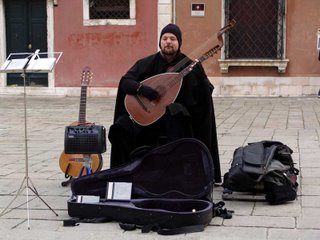40. Have lute will travel
 There's something uniquely Venetian about standing and listening to a street busker playing a Renaissance lute on a bitterly cold day outside the church of Santa Maria Gloriosa dei Frari, better known simply as 'The Frari', in San Polo.
There's something uniquely Venetian about standing and listening to a street busker playing a Renaissance lute on a bitterly cold day outside the church of Santa Maria Gloriosa dei Frari, better known simply as 'The Frari', in San Polo.This unusual instrument with an extra set of bass strings is a modern version of a type of lute known as an 'arch lute' or 'theorbe lute', which was very popular with some Italian composers for solo pieces. The longer scale length of the extra strings gives the instrument a bigger sound than the normally more muted sound of a regular lute.
Lutes became widely used in the middle ages from about 1400 onwards, until keyboard instruments like the harpsichord and later the forte piano allowed more complex music to be played more easily. The lute was not invented in Europe, though, it and its antecedents had been around in the Middle East for several millennia before it came to the west – possibly via the moors of southern Spain, or possibly with crusaders returning from the Holy Lands. The word 'busker' itself almost certainly comes from the Middle Spanish word 'Buskar' meaning to wander, which became a noun meaning 'wandering minstrel'
The intricate but gentle music this busker played sounded to me very like a composition from Venice's own Antonio Vivaldi, but unless it was a transcription for solo lute, it was more likely written by one of his contemporaries. Although Vivaldi wrote for the lute, I don't think any of his pieces were for the solo instrument.
The monkish hat and cape must have helped to stave off the worst of the cold for this busker, but playing this particular instrument in the open air in the middle of January, even wearing gloves with the fingertips cut out, must have been very challenging, so most of the small audience of tourists around that morning showed their appreciation of his effort by contributing a few small coins.

1 Comments:
bottes ugg, ugg pas cher, louis vuitton, pandora jewelry, moncler, moncler, doudoune canada goose, replica watches, louis vuitton, moncler, juicy couture outlet, moncler, juicy couture outlet, ugg,uggs,uggs canada, canada goose, ugg,ugg australia,ugg italia, pandora charms, canada goose, links of london, canada goose outlet, pandora charms, canada goose uk, canada goose, marc jacobs, moncler, wedding dresses, louis vuitton, canada goose outlet, karen millen, louis vuitton, moncler outlet, sac louis vuitton pas cher, coach outlet, moncler, swarovski, ugg boots uk, toms shoes, moncler, pandora jewelry, canada goose, montre pas cher, thomas sabo, supra shoes, hollister, swarovski crystal
Post a Comment
<< Home